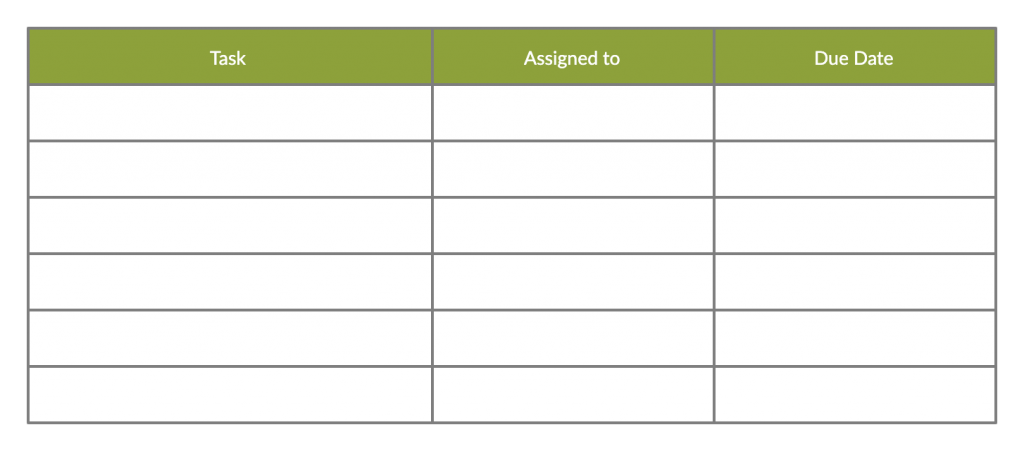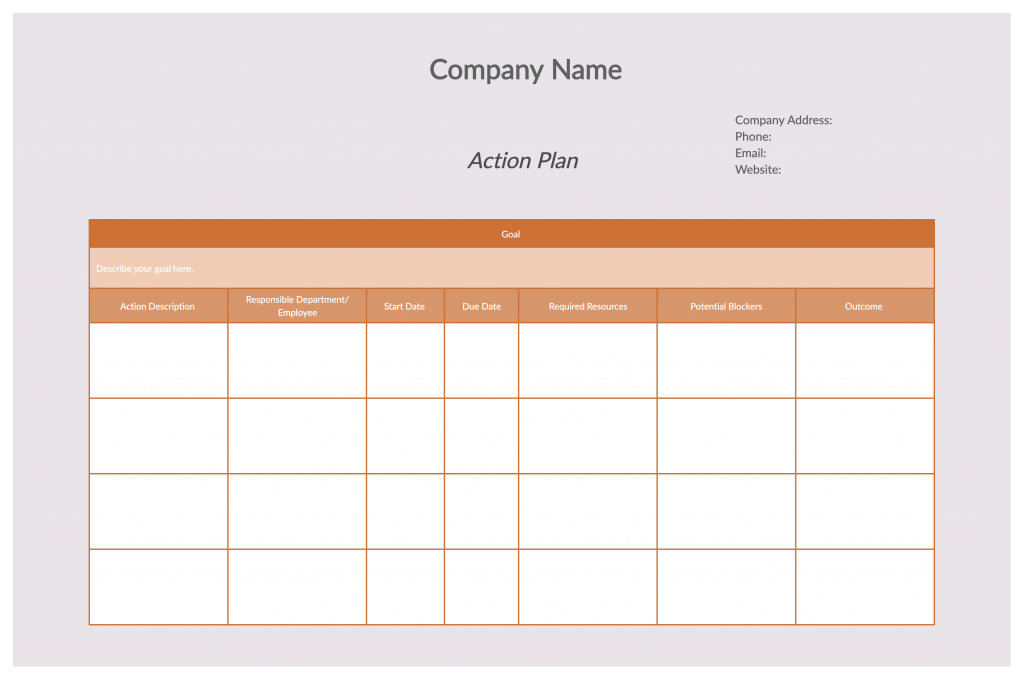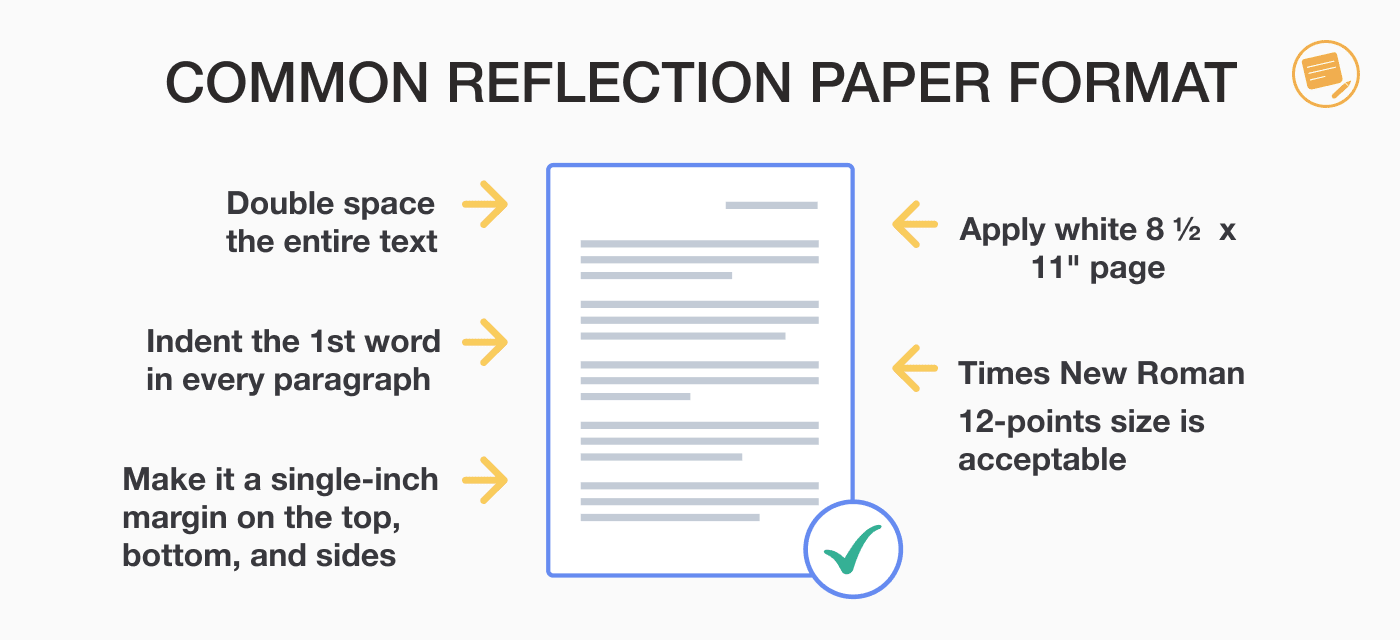
Business Action Plan Template (Click on the template to edit it online)
The point of this step is to create something that everyone can understand at a glance and that can be shared with everyone.
What’s great about having everything listed down on one location is that it makes it easier to track progress and effectively plan things out.
Whether your action plan comes in the shape of a flowchart, Gantt chart, or table, make sure that it clearly communicates the elements we have identified so far – tasks, task owners, deadlines, resources, etc.
Step 7: Monitor, evaluate and update

From the looks of it, creating an action plan seems fairly easy. But there are several important steps you need to follow with caution in order to get the best out of it. Here’s how to write an action plan explained in 6 easy steps.
From an individual employee in an organization to larger departments can make use of action plans to steer their way towards completing their goals.
If you are not clear about what you want to do and what you want to achieve, you are setting yourself up for failure.
This will also bring out the tasks that are pending or delayed, in which case you need to figure out why and find suitable solutions. And then update the action plan accordingly.
Here is what you need to know about writing an effective reflection paper. Stick around until the end of our guide to get some useful writing tips from the writing team at EssayPro — professional paper writing service.
- How my views on rap music have changed over time
- My reflection and interpretation of Moby Dick by Herman Melville
- Why my theory about the size of the universe has changed over time
- How my observations for clinical psychological studies have developed in the last year
Do you need a helping hand with your reflection paper outline? Count on the support of our professional writers.
As with any conclusion, you should summarize what you’ve learned from the experience. Tell the reader how your newfound knowledge has affected your understanding of the subject in general. Describe the feeling and overall lesson you had as a result of the reading or experience.
Reflection Paper Format

- State what you are analysing: a passage, a lecture, an academic article, an experience, etc. )
- Briefly summarize the work.
- Write a thesis statement stating how your subject has affected you.
Everyone has their own style of writing a reflective essay – and that’s the beauty of it, you have plenty of leeway with this type of paper – but, there are still a few tips everyone should incorporate.
If you are writing about a book or an academic article, your reflection may include quotes and passages. They give your reader a point of reference to fully understand your feedback. Feel free to describe what you saw, what you heard, and how you felt.
There are some high-level strategic guidelines beyond the advice included in this free business plan template that can help you write an effective, complete plan while minimizing busywork.
- Executive summary. A one-page summary of your whole plan, typically written after the rest of the plan is completed.
- Company description. An overview can include many potential sub-sections, from the basics (your type of business model) to the meaningful (your business’ vision and mission statement).
- Market analysis. Everything from estimated market size to your target markets. It’ll also include a competitive analysis of your industry to address competitors strengths and weaknesses.
- Products and services. What you sell and the most important features of your products or services. It’ll also include any plans for intellectual property, like patent filings or copyright. If you do market research for your products, it’ll show up in this section of your business plan.
- Marketing plan. How you intend to get the word out about your business, and what strategic decisions you’ve made about things like your pricing strategy.
- Logistics and operations plan. Everything that needs to happen to turn your raw materials into products and get them into the hands of your customers.
- Financial plan. It’s important to include a look at your financial projections. This section includes templates for three key financial statements: an income statement, a balance sheet, and a cash-flow statement.
That said, it may not include the specific details or structure preferred by a potential investor or lender. If your goal with a business plan is to secure funding, check with your target organizations—typically banks or investors—to see if they have a template you can follow to maximize your chances of success.
Almost there: please enter your email below to gain instant access.
Thanks for subscribing. You’ll start receiving free tips and resources soon. In the meantime, start building your store with a free 14-day trial of Shopify.

- Evaluate your business ideas. Whether you’ve got one business idea or many, a business plan can make an idea more tangible, helping you see if it’s truly viable.
- Plan for your next phase. Whether your goal is to start a new business or scale an existing business to the next level, a business plan can help you understand what needs to happen and identify gaps to address.
- Clarify marketing strategy, goals, and tactics. Writing a business plan can show you the actionable next steps to take on a big, abstract idea. It can also help you narrow your strategy and identify clear-cut tactics that will support it.
- Scope the necessary work. Without a concrete plan, cost overruns and delays are all but certain. A business plan can help you see the full scope of work to be done and adjust your investment of time and money accordingly.
- Hire and build partnerships. When you need buy-in from potential employees and partners, especially in the early stages of your business, a clearly written business plan is one of the best tools at your disposal. A business plan provides a refined look at your goals for the business, letting partners judge for themselves whether or not they agree with your vision.
- Secure funds. Securing funding for your business, whether from venture capital or a bank, is one of the most common reasons to create a business plan.
The sample is set up to help you get a sense of each section and understand how they apply to the planning and evaluation stages of a business plan. If you’re looking for funding, this example won’t be a complete or formal look at a business plan, but it will give you a great place to start and notes about where to expand.
This template is designed to ensure you’re thinking through all of the important facets of starting a new business. It’s intended to help new entrepreneurs and small business owners consider the full scope of running a business and identify functional areas they may not have considered or where they may need to level up their skills as they grow.
- No blank-page paralysis. A blank page can be intimidating to even the most seasoned writers. Using an established framework and guidelines can help you get past the inertia of starting your business plan, and it allows you to skip the work of building an outline from scratch. You can always adjust a template to suit your needs.
- Guidance on what to include in each section. If you’ve never sat through a business class, you might never have created a SWOT analysis or a balance sheet before. Templates that offer guidance—in plain language—about how to fill in each section can help you navigate sometimes-daunting business jargon and create a complete and effective plan.
- Knowing you’ve considered every section. In some cases, you may not need to complete every section of a startup business plan template, but its initial structure shows you you’re choosing to omit a section as opposed to forgetting to include it in the first place.

Solving a problem? Analyze the situation and explore possible solutions before prioritizing them.
Maybe you are about to create your very first action plan, or you are already a pro in writing them. Either way, we’d like to hear your opinions on how to write an action plan. Do share them with us in the comments section below.
If you are not clear about what you want to do and what you want to achieve, you are setting yourself up for failure.
The point of this step is to create something that everyone can understand at a glance and that can be shared with everyone.
Step 1: Define your end goal

We have outlined 6 steps explaining how to write an action plan. Once you familiarize yourself with them, go ahead and use the editable templates below to start planning right away.
This will also bring out the tasks that are pending or delayed, in which case you need to figure out why and find suitable solutions. And then update the action plan accordingly.
Planning helps you prepare for the obstacles ahead and keep you on track. And with an effective action plan, you can boost your productivity and keep yourself focused.

The best way to organize thoughts is to create a Mind-Map. Here’s how Mind-Maps often look:
Here’s a rough guide for how many key ideas you’ll want depending on your essay length:
- 1000-word essay: 3 to 4 key ideas
- 1500-word essay: 5 to 7 key ideas
- 2000-word essay: 6 to 8 key ideas
- 3000-word essay: 9 to 12 key ideas
I’ve already got my first sentence and my brainstormed ideas. Let’s build on them to write a draft paragraph:
Then, select the biggest and most important key ideas that you think are worth discussing in the essay. To decide on these, you might want to look back at the notes you took in Step 2.
5. Write your topic Sentences in just 5 minutes. Here’s how.
This strategy helps you to hone-in on exactly what you want to talk about. These are the key phrases you’re going to use frequently in your writing and use when you look for sources to cite in your essay!
When you write your first draft, don’t put pressure on yourself. Remind yourself that this is the first of several attempts at creating a great essay, so it doesn’t need to be perfect right away. The important thing is that you get words down on paper.
Once you’ve read the assigned lecture slides and readings, you should have a good preliminary list of ideas, topics, statistics and even quotes that you can use in step 3.
- “Most scientists believe climate change is caused by humans. In fact, according to the IPCC, over 98% of climate change scientists accept the scientific data that climate change is caused by humans (IPCC, 2018). This figure is very high, signalling overwhelming expert consensus. This consensus holds that the emission of carbon from burning of fossil fuels in the 20 th Century is trapping heat into the atmosphere. However, a minority of dissenting scientists continue to claim that this carbon build-up is mostly the fault of natural forces such as volcanoes which emit enormous amounts of carbon into the atmosphere (Bier, 2013).”

